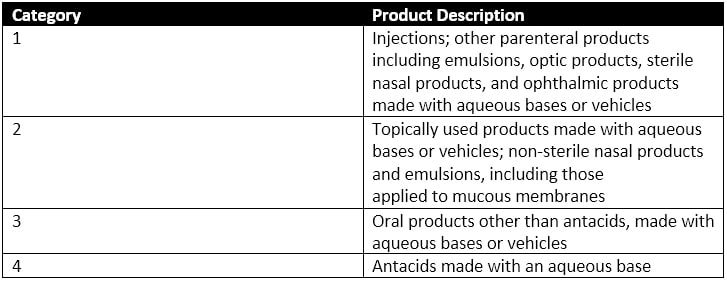Preservative Efficacy Testing For Medical Devices
What are preservatives?
Preservatives are substances mixed into creams, gels, and other liquids. Preservatives are used to prevent the growth of bacteria, fungi, and other microorganisms within a medical, cosmetic, household, or food product. Preservatives also help to keep the freshness of the appearance of a product and keep its consistency intact over time. This article covers FDA medical device efficacy for medical preservative liquids and substances, preservative efficacy testing methods, and preservative efficacy testing reports for PET tests.
Why is preservative efficacy testing important?
Preservative efficacy testing (PET), also known as preservative challenge testing, determines the effectiveness of a preservative during its shelf life and evaluates how well a product withstands microbial contamination during use. For example, in sterile vials containing multiple doses, antimicrobial preservatives are used to inhibit the growth of any microorganisms that may be introduced during repeated insertion and withdrawal to load individual amounts.
PET can also be used to determine the best preservative to use in your formulation and the minimum effective concentration of that particular preservative needed to preserve the pharmaceutical, food, or biotechnology product being assessed. Note that the minimum effective concentration of a preservative should be well below any concentration level that is toxic to humans.
What types of products does preservative efficacy testing assess?
Preservative testing efficacy methods can evaluate four categories of products with preservative challenge testing. These product categories are detailed in Table 1 of USP 51, which is reproduced below.

How is preservative efficacy testing performed?
For FDA medical device efficacy preservative testing, cultures of Candida albicans (ATCC No. 10231), Aspergillus brasiliensis (ATCC No. 16404),
Escherichia coli (ATCC No. 8739), Pseudomonas aeruginosa (ATCC No. 9027), and Staphylococcus aureus (ATCC No. 6538) are prepared. Stock cultures of these organisms are often created by centrifugation of an ATCC culture to collect all of the cells in one place, washing the previous culture to remove residual media of the prior culture, and resuspending the microorganisms in a sterile suspension fluid. The suspension fluids for each microorganism referenced above are prepared at a microbial count of about 1 × 108 colony-forming units per milliliter (CFU/mL).
PET is performed in five sterile, capped containers. Suppose the original container of a product under assessment is sterile, can be entered aseptically, and holds an appropriate volume of the product being tested. In that case, the original containers with the filled product may be used. Each of the five product samples is injected with a test suspension of either Candida albicans, Aspergillus brasiliensis, Escherichia coli, Pseudomonas aeruginosa, or Staphylococcus aureus. Note that each product sample is exposed to only a single microbe of the five listed, and all microbes are exposed to the product during testing. The microbial test suspension injected is between 0.5%- 1% of the volume of the product under assessment and is at a concentration of 1 × 105 and 1 × 106 CFU/ml of the product for category 1-3 products. The final concentration per ml of product for category 4 products is between 1 × 103 and 1 × 104 CFU/mL.
Each of the five product samples with their respective microbial injections is incubated at a simulated room temperature of 22.5 ± 2.5°C or 32.5 ± 2.5°C depending upon the microbe the product sample is exposed. Microbial counts are taken at 7, 14, and 28 days for most microorganisms tested. The plate-count method is used to determine the number of CFU present in each of the inoculated product samples. This plate-count method is completed in duplicate. Once all counts are taken, the change in log10 of the concentration of CFU/ml is calculated for each microorganism. The requirements for antimicrobial effectiveness are met if no increase in microbial growth for the various organisms tested occurs within the timeframes specific to each organism. are met. No increase in microbial growth is defined as not more than 0.5 log10 units more than the previous microbial growth value.
Summary
Overall, preservative efficacy testing methods are critical for all products prepared for human use or consumption. PET evaluates four categories of products, injectables, topicals, orals, and antacids made with an aqueous base. PET gives quantitative data on whether the antimicrobial effectiveness criteria have been met and is a key part of FDA medical device efficacy for products with preservatives. Furthermore, if the formulation of a particular product changes, additional preservative efficacy testing will need to be performed to ensure regulatory approval of the new formulation.
MycoScience is a contract manufacturing organization specializing in sterile syringe and vial filling. MycoScience also offers Preservative Efficacy Testing, Sterilization Validations, Bioburden Testing, Cleaning Validations, Microbial Aerosol Challenge Testing, Accelerated Aging, Microbiology Testing, Cytotoxicity Testing, Bacterial Endotoxin Testing, EO Residual Testing, Package Integrity Testing & Environmental Monitoring services medical devices and allied industries. MycoScience is an ISO 13485 certified facility.
References
United States Pharmacopeial Convention. <51> Antimicrobial Effectiveness Testing. Rockville, MD, USA. 2021. (USPC <51>).
Sharing this in your social netwroks

